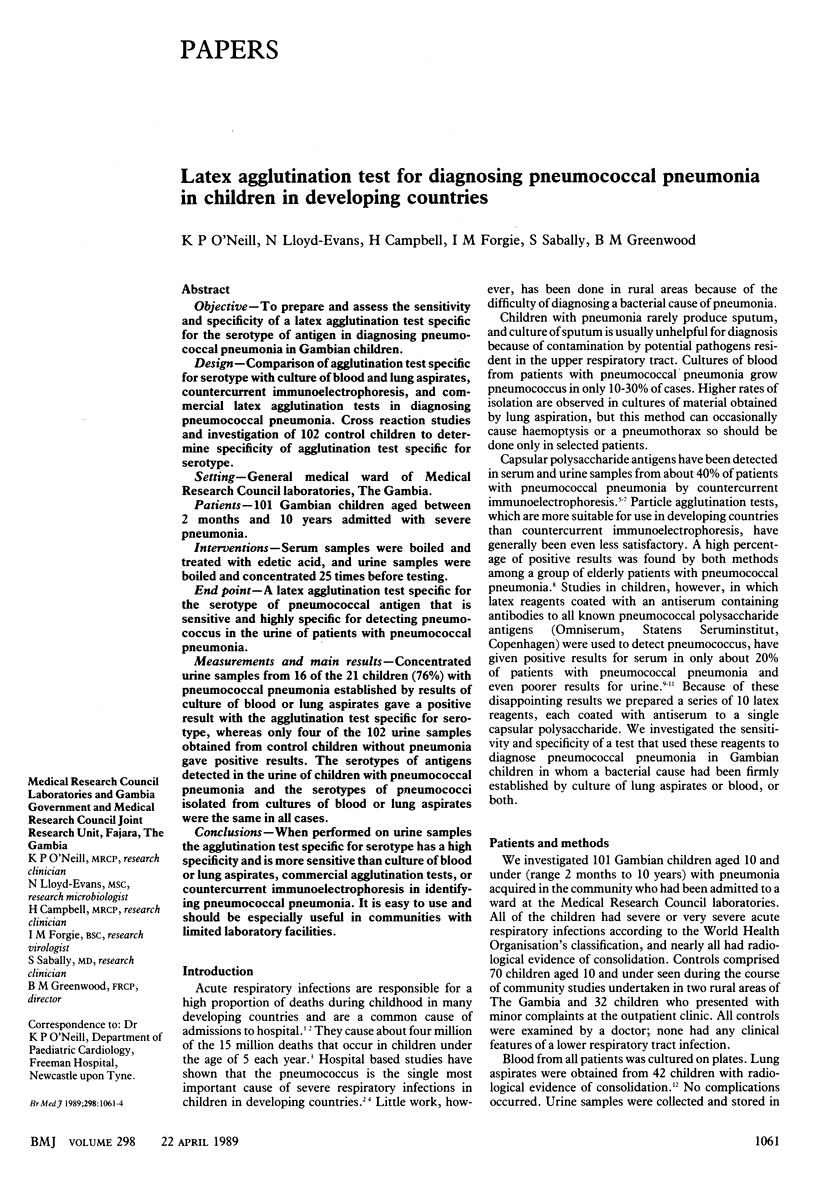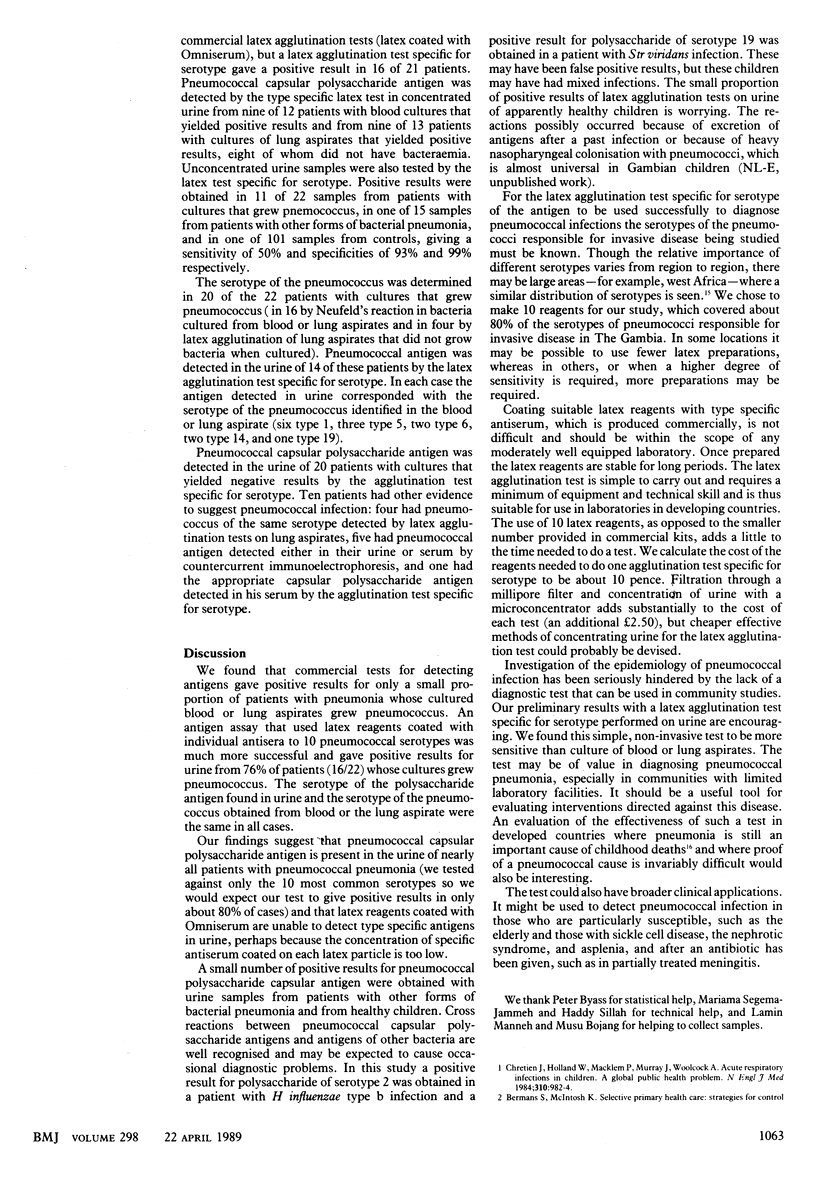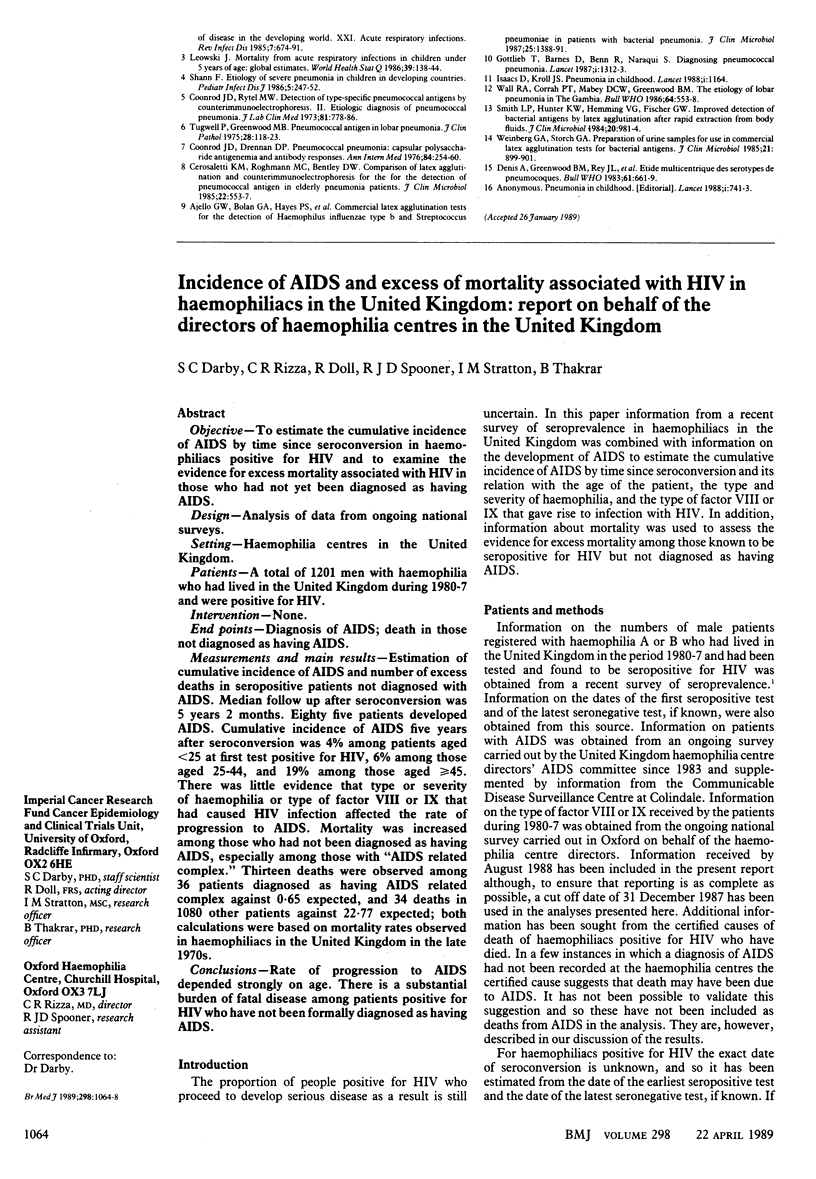Abstract
OBJECTIVE--To prepare and assess the sensitivity and specificity of a latex agglutination test specific for the serotype of antigen in diagnosing pneumococcal pneumonia in Gambian children. DESIGN--Comparison of agglutination test specific for serotype with culture of blood and lung aspirates, countercurrent immunoelectrophoresis, and commercial latex agglutination tests in diagnosing pneumococcal pneumonia. Cross reaction studies and investigation of 102 control children to determine specificity of agglutination test specific for serotype. SETTING--General medical ward of Medical Research Council laboratories, The Gambia. PATIENTS--101 Gambian children aged between 2 months and 10 years admitted with severe pneumonia. INTERVENTIONS--Serum samples were boiled and treated with edetic acid, and urine samples were boiled and concentrated 25 times before testing. END POINT--A latex agglutination test specific for the serotype of pneumococcal antigen that is sensitive and highly specific for detecting pneumococcus in the urine of patients with pneumococcal pneumonia. MEASUREMENTS AND MAIN RESULTS--Concentrated urine samples from 16 of the 21 children (76%) with pneumococcal pneumonia established by results of culture of blood or lung aspirates gave a positive result with the agglutination test specific for serotype, whereas only four of the 102 urine samples obtained from control children without pneumonia gave positive results. The serotypes of antigens detected in the urine of children with pneumococcal pneumonia and the serotypes of pneumococci isolated from cultures of blood or lung aspirates were the same in all cases. CONCLUSIONS--When performed on urine samples the agglutination test specific for serotype has a high specificity and is more sensitive than culture of blood or lung aspirates, commercial agglutination tests, or countercurrent immunoelectrophoresis in identifying pneumococcal pneumonia. It is easy to use and should be especially useful in communities with limited laboratory facilities.
Full text
PDF



Selected References
These references are in PubMed. This may not be the complete list of references from this article.
- Ajello G. W., Bolan G. A., Hayes P. S., Lehmann D., Montgomery J., Feeley J. C., Perlino C. A., Broome C. V. Commercial latex agglutination tests for detection of Haemophilus influenzae type b and Streptococcus pneumoniae antigens in patients with bacteremic pneumonia. J Clin Microbiol. 1987 Aug;25(8):1388–1391. doi: 10.1128/jcm.25.8.1388-1391.1987. [DOI] [PMC free article] [PubMed] [Google Scholar]
- Cerosaletti K. M., Roghmann M. C., Bentley D. W. Comparison of latex agglutination and counterimmunoelectrophoresis for the detection of pneumococcal antigen in elderly pneumonia patients. J Clin Microbiol. 1985 Oct;22(4):553–557. doi: 10.1128/jcm.22.4.553-557.1985. [DOI] [PMC free article] [PubMed] [Google Scholar]
- Chretien J., Holland W., Macklem P., Murray J., Woolcock A. Acute respiratory infections in children. A global public-health problem. N Engl J Med. 1984 Apr 12;310(15):982–984. doi: 10.1056/NEJM198404123101509. [DOI] [PubMed] [Google Scholar]
- Coonrod J. D., Drennan D. P. Pneumococcal pneumonia: capsular polysaccharide antigenemia and antibody responses. Ann Intern Med. 1976 Mar;84(3):254–260. doi: 10.7326/0003-4819-84-3-254. [DOI] [PubMed] [Google Scholar]
- Coonrod J. D., Rytel M. W. Detection of type-specific pneumococcal antigens by counterimmunoelectrophoresis. II. Etiologic diagnosis of pneumococcal pneumonia. J Lab Clin Med. 1973 May;81(5):778–786. [PubMed] [Google Scholar]
- Denis F. A., Greenwood B. D., Rey J. L., Prince-David M., Mboup S., Lloyd-Evans N., Williams K., Benbachir I., El Ndaghri N., Hansman D. Etude multicentrique des sérotypes de pneumocoques en Afrique. Bull World Health Organ. 1983;61(4):661–669. [PMC free article] [PubMed] [Google Scholar]
- Gottlieb T., Barnes D., Benn R., Naraqi S. Diagnosing pneumococcal pneumonia. Lancet. 1987 Jun 6;1(8545):1312–1313. doi: 10.1016/s0140-6736(87)90562-9. [DOI] [PubMed] [Google Scholar]
- Leowski J. Mortality from acute respiratory infections in children under 5 years of age: global estimates. World Health Stat Q. 1986;39(2):138–144. [PubMed] [Google Scholar]
- Pneumonia in childhood. Lancet. 1988 May 21;1(8595):1164–1164. [PubMed] [Google Scholar]
- Shann F. Etiology of severe pneumonia in children in developing countries. Pediatr Infect Dis. 1986 Mar-Apr;5(2):247–252. doi: 10.1097/00006454-198603000-00017. [DOI] [PubMed] [Google Scholar]
- Tugwell P., Greenwood B. M. Pneumococcal antigen in lobar pneumonia. J Clin Pathol. 1975 Feb;28(2):118–123. doi: 10.1136/jcp.28.2.118. [DOI] [PMC free article] [PubMed] [Google Scholar]
- Wall R. A., Corrah P. T., Mabey D. C., Greenwood B. M. The etiology of lobar pneumonia in the Gambia. Bull World Health Organ. 1986;64(4):553–558. [PMC free article] [PubMed] [Google Scholar]
- Weinberg G. A., Storch G. A. Preparation of urine samples for use in commercial latex agglutination tests for bacterial antigens. J Clin Microbiol. 1985 Jun;21(6):899–901. doi: 10.1128/jcm.21.6.899-901.1985. [DOI] [PMC free article] [PubMed] [Google Scholar]


